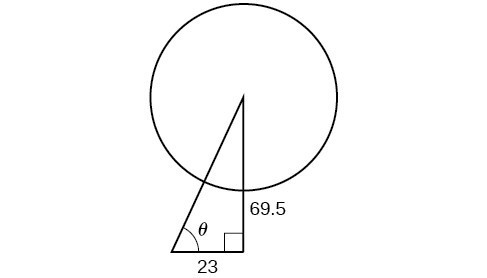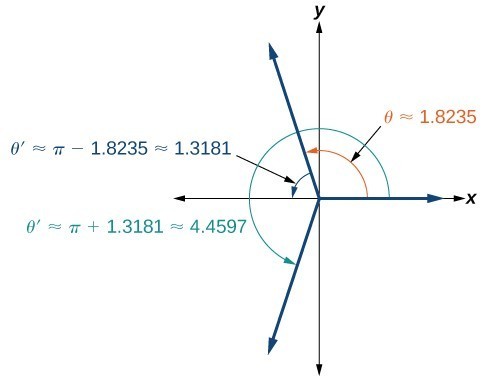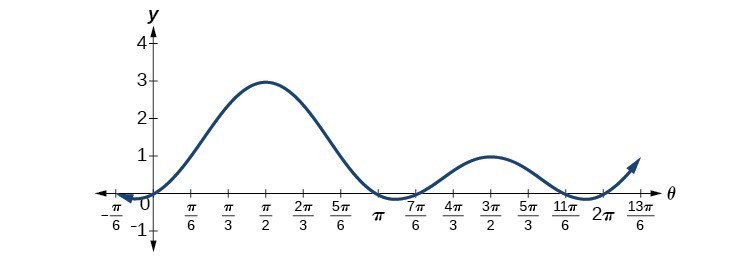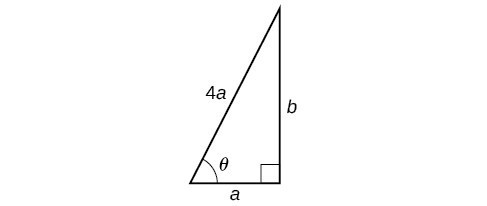Learning Outcomes
- Solve equations involving a single trigonometric function.
- Solve trigonometric equations using a calculator.
- Solve trigonometric equations that involve factoring.
- Solve trigonometric equations using fundamental identities.
- Solve trigonometric equations with multiple angles.
- Solve right triangle problems.
Solving Linear Trigonometric Equations in Sine and Cosine
Trigonometric equations are, as the name implies, equations that involve trigonometric functions. Similar in many ways to solving polynomial equations or rational equations, only specific values of the variable will be solutions, if there are solutions at all. Often we will solve a trigonometric equation over a specified interval. However, just as often, we will be asked to find all possible solutions, and as trigonometric functions are periodic, solutions are repeated within each period. In other words, trigonometric equations may have an infinite number of solutions. Additionally, like rational equations, the domain of the function must be considered before we assume that any solution is valid. The period of both the sine function and the cosine function is [latex]2\pi[/latex]. In other words, every [latex]2\pi[/latex] units, the y-values repeat. If we need to find all possible solutions, then we must add [latex]2\pi k[/latex], where [latex]k[/latex] is an integer, to the initial solution. Recall the rule that gives the format for stating all possible solutions for a function where the period is [latex]2\pi :[/latex]
There are similar rules for indicating all possible solutions for the other trigonometric functions. Solving trigonometric equations requires the same techniques as solving algebraic equations. We read the equation from left to right, horizontally, like a sentence. We look for known patterns, factor, find common denominators, and substitute certain expressions with a variable to make solving a more straightforward process. However, with trigonometric equations, we also have the advantage of using the identities we developed in the previous sections.
Example 1: Solving a Linear Trigonometric Equation Involving the Cosine Function
Find all possible exact solutions for the equation [latex]\cos \theta =\frac{1}{2}[/latex].
Example 2: Solving a Linear Equation Involving the Sine Function
Find all possible exact solutions for the equation [latex]\sin t=\frac{1}{2}[/latex].
How To: Given a trigonometric equation, solve using algebra.
- Look for a pattern that suggests an algebraic property, such as the difference of squares or a factoring opportunity.
- Substitute the trigonometric expression with a single variable, such as [latex]x[/latex] or [latex]u[/latex].
- Solve the equation the same way an algebraic equation would be solved.
- Substitute the trigonometric expression back in for the variable in the resulting expressions.
- Solve for the angle.
Example 3: Solve the Trigonometric Equation in Linear Form
Solve the equation exactly: [latex]2\cos \theta -3=-5,0\le \theta <2\pi[/latex].
Try It
Solve exactly the following linear equation on the interval [latex]\left[0,2\pi \right):2\sin x+1=0[/latex].
Try It
Solve Trigonometric Equations Using a Calculator
Not all functions can be solved exactly using only the unit circle. When we must solve an equation involving an angle other than one of the special angles, we will need to use a calculator. Make sure it is set to the proper mode, either degrees or radians, depending on the criteria of the given problem.
Example 4: Using a Calculator to Solve a Trigonometric Equation Involving Sine
Use a calculator to solve the equation [latex]\sin \theta =0.8[/latex], where [latex]\theta[/latex] is in radians.
Example 5: Using a Calculator to Solve a Trigonometric Equation Involving Secant
Use a calculator to solve the equation [latex]\sec \theta =-4[/latex], giving your answer in radians.
Try It
Solve [latex]\cos \theta =-0.2[/latex].
Try It
Solving Equations Involving a Single Trigonometric Function
When we are given equations that involve only one of the six trigonometric functions, their solutions involve using algebraic techniques and the unit circle. We need to make several considerations when the equation involves trigonometric functions other than sine and cosine. Problems involving the reciprocals of the primary trigonometric functions need to be viewed from an algebraic perspective. In other words, we will write the reciprocal function, and solve for the angles using the function. Also, an equation involving the tangent function is slightly different from one containing a sine or cosine function. First, as we know, the period of tangent is [latex]\pi[/latex], not [latex]2\pi[/latex]. Further, the domain of tangent is all real numbers with the exception of odd integer multiples of [latex]\frac{\pi }{2}[/latex], unless, of course, a problem places its own restrictions on the domain.
Example 6: Solving a Problem Involving a Single Trigonometric Function
Solve the problem exactly: [latex]2{\sin }^{2}\theta -1=0,0\le \theta <2\pi[/latex].
Example 7: Solving a Trigonometric Equation Involving Cosecant
Solve the following equation exactly: [latex]\csc \theta =-2,0\le \theta <4\pi[/latex].
Example 8: Solving an Equation Involving Tangent
Solve the equation exactly: [latex]\tan \left(\theta -\frac{\pi }{2}\right)=1,0\le \theta <2\pi[/latex].
Try It
Find all solutions for [latex]\tan x=\sqrt{3}[/latex].
Try It
Example 9: Identify all Solutions to the Equation Involving Tangent
Identify all exact solutions to the equation [latex]2\left(\tan x+3\right)=5+\tan x,0\le x<2\pi[/latex].
Solving Trigonometric Equations in Quadratic Form
Solving a quadratic equation may be more complicated, but once again, we can use algebra as we would for any quadratic equation. Look at the pattern of the equation. Is there more than one trigonometric function in the equation, or is there only one? Which trigonometric function is squared? If there is only one function represented and one of the terms is squared, think about the standard form of a quadratic. Replace the trigonometric function with a variable such as [latex]x[/latex] or [latex]u[/latex]. If substitution makes the equation look like a quadratic equation, then we can use the same methods for solving quadratics to solve the trigonometric equations.
Example 10: Solving a Trigonometric Equation in Quadratic Form
Solve the equation exactly: [latex]{\cos }^{2}\theta +3\cos \theta -1=0,0\le \theta <2\pi[/latex].
Example 11: Solving a Trigonometric Equation in Quadratic Form by Factoring
Solve the equation exactly: [latex]2{\sin }^{2}\theta -5\sin \theta +3=0,0\le \theta \le 2\pi[/latex].
Try It
Solve [latex]{\sin }^{2}\theta =2\cos \theta +2,0\le \theta \le 2\pi[/latex]. [Hint: Make a substitution to express the equation only in terms of cosine.]
Try It
Example 12: Solving a Trigonometric Equation Using Algebra
Solve exactly:
[latex]2{\sin }^{2}\theta +\sin \theta =0;0\le \theta <2\pi[/latex]
Example 13: Solving a Trigonometric Equation Quadratic in Form
Solve the equation quadratic in form exactly: [latex]2{\sin }^{2}\theta -3\sin \theta +1=0,0\le \theta <2\pi[/latex].
Try It
Solve the quadratic equation [latex]2{\cos }^{2}\theta +\cos \theta =0[/latex].
Solving Trigonometric Equations Using Fundamental Identities
While algebra can be used to solve a number of trigonometric equations, we can also use the fundamental identities because they make solving equations simpler. Remember that the techniques we use for solving are not the same as those for verifying identities. The basic rules of algebra apply here, as opposed to rewriting one side of the identity to match the other side. In the next example, we use two identities to simplify the equation.
Example 14: Use Identities to Solve an Equation
Use identities to solve exactly the trigonometric equation over the interval [latex]0\le x<2\pi[/latex].
[latex]\cos x\cos \left(2x\right)+\sin x\sin \left(2x\right)=\frac{\sqrt{3}}{2}[/latex]
Example 15: Solving the Equation Using a Double-Angle Formula
Solve the equation exactly using a double-angle formula: [latex]\cos \left(2\theta \right)=\cos \theta[/latex].
Example 16: Solving an Equation Using an Identity
Solve the equation exactly using an identity: [latex]3\cos \theta +3=2{\sin }^{2}\theta ,0\le \theta <2\pi[/latex].
Try It
Solving Trigonometric Equations with Multiple Angles
Sometimes it is not possible to solve a trigonometric equation with identities that have a multiple angle, such as [latex]\sin \left(2x\right)[/latex] or [latex]\cos \left(3x\right)[/latex]. When confronted with these equations, recall that [latex]y=\sin \left(2x\right)[/latex] is a horizontal compression by a factor of 2 of the function [latex]y=\sin x[/latex]. On an interval of [latex]2\pi[/latex], we can graph two periods of [latex]y=\sin \left(2x\right)[/latex], as opposed to one cycle of [latex]y=\sin x[/latex]. This compression of the graph leads us to believe there may be twice as many x-intercepts or solutions to [latex]\sin \left(2x\right)=0[/latex] compared to [latex]\sin x=0[/latex]. This information will help us solve the equation.
Example 17: Solving a Multiple Angle Trigonometric Equation
Solve exactly: [latex]\cos \left(2x\right)=\frac{1}{2}[/latex] on [latex]\left[0,2\pi \right)[/latex].
Solving Right Triangle Problems
We can now use all of the methods we have learned to solve problems that involve applying the properties of right triangles and the Pythagorean Theorem. We begin with the familiar Pythagorean Theorem, [latex]{a}^{2}+{b}^{2}={c}^{2}[/latex], and model an equation to fit a situation.
Example 18: Using the Pythagorean Theorem to Model an Equation
Use the Pythagorean Theorem, and the properties of right triangles to model an equation that fits the problem.
One of the cables that anchors the center of the London Eye Ferris wheel to the ground must be replaced. The center of the Ferris wheel is 69.5 meters above the ground, and the second anchor on the ground is 23 meters from the base of the Ferris wheel. Approximately how long is the cable, and what is the angle of elevation (from ground up to the center of the Ferris wheel)?

Figure 4
Example 19: Using the Pythagorean Theorem to Model an Abstract Problem
OSHA safety regulations require that the base of a ladder be placed 1 foot from the wall for every 4 feet of ladder length. Find the angle that a ladder of any length forms with the ground and the height at which the ladder touches the wall.
Key Concepts
- When solving linear trigonometric equations, we can use algebraic techniques just as we do solving algebraic equations. Look for patterns, like the difference of squares, quadratic form, or an expression that lends itself well to substitution.
- Equations involving a single trigonometric function can be solved or verified using the unit circle.
- We can also solve trigonometric equations using a graphing calculator.
- Many equations appear quadratic in form. We can use substitution to make the equation appear simpler, and then use the same techniques we use solving an algebraic quadratic: factoring, the quadratic formula, etc.
- We can also use the identities to solve trigonometric equation.
- We can use substitution to solve a multiple-angle trigonometric equation, which is a compression of a standard trigonometric function. We will need to take the compression into account and verify that we have found all solutions on the given interval.
- Real-world scenarios can be modeled and solved using the Pythagorean Theorem and trigonometric functions.
Section 5.5 Homework Exercises
1. Will there always be solutions to trigonometric function equations? If not, describe an equation that would not have a solution. Explain why or why not.
2. When solving a trigonometric equation involving more than one trig function, do we always want to try to rewrite the equation so it is expressed in terms of one trigonometric function? Why or why not?
3. When solving linear trig equations in terms of only sine or cosine, how do we know whether there will be solutions?
For the following exercises, find all solutions exactly on the interval [latex]0\le \theta <2\pi[/latex]. 4. [latex]2\sin \theta =-\sqrt{2}[/latex] 5. [latex]2\sin \theta =\sqrt{3}[/latex] 6. [latex]2\cos \theta =1[/latex] 7. [latex]2\cos \theta =-\sqrt{2}[/latex] 8. [latex]\tan \theta =-1[/latex] 9. [latex]\tan x=1[/latex] 10. [latex]\cot x+1=0[/latex] 11. [latex]4{\sin }^{2}x - 2=0[/latex] 12. [latex]{\csc }^{2}x - 4=0[/latex] For the following exercises, solve exactly on [latex]\left[0,2\pi \right)[/latex]. 13. [latex]2\cos \theta =\sqrt{2}[/latex] 14. [latex]2\cos \theta =-1[/latex] 15. [latex]2\sin \theta =-1[/latex] 16. [latex]2\sin \theta =-\sqrt{3}[/latex] 17. [latex]2\sin \left(3\theta \right)=1[/latex] 18. [latex]2\sin \left(2\theta \right)=\sqrt{3}[/latex] 19. [latex]2\cos \left(3\theta \right)=-\sqrt{2}[/latex] 20. [latex]\cos \left(2\theta \right)=-\frac{\sqrt{3}}{2}[/latex] 21. [latex]2\sin \left(\pi \theta \right)=1[/latex] 22. [latex]2\cos \left(\frac{\pi }{5}\theta \right)=\sqrt{3}[/latex] For the following exercises, find all exact solutions on [latex]\left[0,2\pi \right)[/latex]. 23. [latex]\sec \left(x\right)\sin \left(x\right)-2\sin \left(x\right)=0[/latex] 24. [latex]\tan \left(x\right)-2\sin \left(x\right)\tan \left(x\right)=0[/latex] 25. [latex]2{\cos }^{2}t+\cos \left(t\right)=1[/latex] 26. [latex]2{\tan }^{2}\left(t\right)=3\sec \left(t\right)[/latex] 27. [latex]2\sin \left(x\right)\cos \left(x\right)-\sin \left(x\right)+2\cos \left(x\right)-1=0[/latex] 28. [latex]{\cos }^{2}\theta =\frac{1}{2}[/latex] 29. [latex]{\sec }^{2}x=1[/latex] 30. [latex]{\tan }^{2}\left(x\right)=-1+2\tan \left(-x\right)[/latex] 31. [latex]8{\sin }^{2}\left(x\right)+6\sin \left(x\right)+1=0[/latex] 32. [latex]{\tan }^{5}\left(x\right)=\tan \left(x\right)[/latex] For the following exercises, solve with the methods shown in this section exactly on the interval [latex]\left[0,2\pi \right)[/latex]. 33. [latex]\sin \left(3x\right)\cos \left(6x\right)-\cos \left(3x\right)\sin \left(6x\right)=-0.9[/latex] 34. [latex]\sin \left(6x\right)\cos \left(11x\right)-\cos \left(6x\right)\sin \left(11x\right)=-0.1[/latex] 35. [latex]\cos \left(2x\right)\cos x+\sin \left(2x\right)\sin x=1[/latex] 36. [latex]6\sin \left(2t\right)+9\sin t=0[/latex] 37. [latex]9\cos \left(2\theta \right)=9{\cos }^{2}\theta -4[/latex] 38. [latex]\sin \left(2t\right)=\cos t[/latex] 39. [latex]\cos \left(2t\right)=\sin t[/latex] 40. [latex]\cos \left(6x\right)-\cos \left(3x\right)=0[/latex] For the following exercises, solve exactly on the interval [latex]\left[0,2\pi \right)[/latex]. Use the quadratic formula if the equations do not factor. 41. [latex]{\tan }^{2}x-\sqrt{3}\tan x=0[/latex] 42. [latex]{\sin }^{2}x+\sin x - 2=0[/latex] 43. [latex]{\sin }^{2}x - 2\sin x - 4=0[/latex] 44. [latex]5{\cos }^{2}x+3\cos x - 1=0[/latex] 45. [latex]3{\cos }^{2}x - 2\cos x - 2=0[/latex] 46. [latex]5{\sin }^{2}x+2\sin x - 1=0[/latex] 47. [latex]{\tan }^{2}x+5\tan x - 1=0[/latex] 48. [latex]{\cot }^{2}x=-\cot x[/latex] 49. [latex]-{\tan }^{2}x-\tan x - 2=0[/latex] For the following exercises, find exact solutions on the interval [latex]\left[0,2\pi \right)[/latex]. Look for opportunities to use trigonometric identities. 50. [latex]{\sin }^{2}x-{\cos }^{2}x-\sin x=0[/latex] 51. [latex]{\sin }^{2}x+{\cos }^{2}x=0[/latex] 52. [latex]\sin \left(2x\right)-\sin x=0[/latex] 53. [latex]\cos \left(2x\right)-\cos x=0[/latex] 54. [latex]\frac{2\tan x}{2-{\sec }^{2}x}-{\sin }^{2}x={\cos }^{2}x[/latex] 55. [latex]1-\cos \left(2x\right)=1+\cos \left(2x\right)[/latex] 56. [latex]{\sec }^{2}x=7[/latex] 57. [latex]10\sin x\cos x=6\cos x[/latex] 58. [latex]-3\sin t=15\cos t\sin t[/latex] 59. [latex]4{\cos }^{2}x - 4=15\cos x[/latex] 60. [latex]8{\sin }^{2}x+6\sin x+1=0[/latex] 61. [latex]8{\cos }^{2}\theta =3 - 2\cos \theta[/latex] 62. [latex]6{\cos }^{2}x+7\sin x - 8=0[/latex] 63. [latex]12{\sin }^{2}t+\cos t - 6=0[/latex] 64. [latex]\tan x=3\sin x[/latex] 65. [latex]{\cos }^{3}t=\cos t[/latex] For the following exercises, algebraically determine all solutions of the trigonometric equation exactly, then verify the results by graphing the equation and finding the zeros. 66. [latex]6{\sin }^{2}x - 5\sin x+1=0[/latex] 67. [latex]8{\cos }^{2}x - 2\cos x - 1=0[/latex] 68. [latex]100{\tan }^{2}x+20\tan x - 3=0[/latex] 69. [latex]2{\cos }^{2}x-\cos x+15=0[/latex] 70. [latex]20{\sin }^{2}x - 27\sin x+7=0[/latex] 71. [latex]2{\tan }^{2}x+7\tan x+6=0[/latex] 72. [latex]130{\tan }^{2}x+69\tan x - 130=0[/latex] For the following exercises, use a calculator to find all solutions to four decimal places. 73. [latex]\sin x=0.27[/latex] 74. [latex]\sin x=-0.55[/latex] 75. [latex]\tan x=-0.34[/latex] 76. [latex]\cos x=0.71[/latex] For the following exercises, solve the equations algebraically, and then use a calculator to find the values on the interval [latex]\left[0,2\pi \right)[/latex]. Round to four decimal places. 77. [latex]{\tan }^{2}x+3\tan x - 3=0[/latex] 78. [latex]6{\tan }^{2}x+13\tan x=-6[/latex] 79. [latex]{\tan }^{2}x-\sec x=1[/latex] 80. [latex]{\sin }^{2}x - 2{\cos }^{2}x=0[/latex] 81. [latex]2{\tan }^{2}x+9\tan x - 6=0[/latex] 82. [latex]4{\sin }^{2}x+\sin \left(2x\right)\sec x - 3=0[/latex] For the following exercises, find all solutions exactly to the equations on the interval [latex]\left[0,2\pi \right)[/latex]. 83. [latex]{\csc }^{2}x - 3\csc x - 4=0[/latex] 84. [latex]{\sin }^{2}x-{\cos }^{2}x - 1=0[/latex] 85. [latex]{\sin }^{2}x\left(1-{\sin }^{2}x\right)+{\cos }^{2}x\left(1-{\sin }^{2}x\right)=0[/latex] 86. [latex]3{\sec }^{2}x+2+{\sin }^{2}x-{\tan }^{2}x+{\cos }^{2}x=0[/latex] 87. [latex]{\sin }^{2}x - 1+2\cos \left(2x\right)-{\cos }^{2}x=1[/latex] 88. [latex]{\tan }^{2}x - 1-{\sec }^{3}x\cos x=0[/latex] 89. [latex]\frac{\sin \left(2x\right)}{{\sec }^{2}x}=0[/latex] 90. [latex]\frac{\sin \left(2x\right)}{2{\csc }^{2}x}=0[/latex] 91. [latex]2{\cos }^{2}x-{\sin }^{2}x-\cos x - 5=0[/latex] 92. [latex]\frac{1}{{\sec }^{2}x}+2+{\sin }^{2}x+4{\cos }^{2}x=4[/latex] 93. An airplane has only enough gas to fly to a city 200 miles northeast of its current location. If the pilot knows that the city is 25 miles north, how many degrees north of east should the airplane fly? 94. If a loading ramp is placed next to a truck, at a height of 4 feet, and the ramp is 15 feet long, what angle does the ramp make with the ground? 95. If a loading ramp is placed next to a truck, at a height of 2 feet, and the ramp is 20 feet long, what angle does the ramp make with the ground? 96. A woman is watching a launched rocket currently 11 miles in altitude. If she is standing 4 miles from the launch pad, at what angle is she looking up from horizontal? 97. An astronaut is in a launched rocket currently 15 miles in altitude. If a man is standing 2 miles from the launch pad, at what angle is she looking down at him from horizontal? (Hint: this is called the angle of depression.) 98. A woman is standing 8 meters away from a 10-meter tall building. At what angle is she looking to the top of the building? 99. A man is standing 10 meters away from a 6-meter tall building. Someone at the top of the building is looking down at him. At what angle is the person looking at him? 100. A 20-foot tall building has a shadow that is 55 feet long. What is the angle of elevation of the sun? 101. A 90-foot tall building has a shadow that is 2 feet long. What is the angle of elevation of the sun? 102. A spotlight on the ground 3 meters from a 2-meter tall man casts a 6 meter shadow on a wall 6 meters from the man. At what angle is the light? 103. A spotlight on the ground 3 feet from a 5-foot tall woman casts a 15-foot tall shadow on a wall 6 feet from the woman. At what angle is the light? For the following exercises, find a solution to the following word problem algebraically. Then use a calculator to verify the result. Round the answer to the nearest tenth of a degree. 104. A person does a handstand with his feet touching a wall and his hands 1.5 feet away from the wall. If the person is 6 feet tall, what angle do his feet make with the wall? 105. A person does a handstand with her feet touching a wall and her hands 3 feet away from the wall. If the person is 5 feet tall, what angle do her feet make with the wall? 106. A 23-foot ladder is positioned next to a house. If the ladder slips at 7 feet from the house when there is not enough traction, what angle should the ladder make with the ground to avoid slipping?
Candela Citations
- Precalculus. Authored by: OpenStax College. Provided by: OpenStax. Located at: http://cnx.org/contents/fd53eae1-fa23-47c7-bb1b-972349835c3c@5.175:1/Preface. License: CC BY: Attribution


